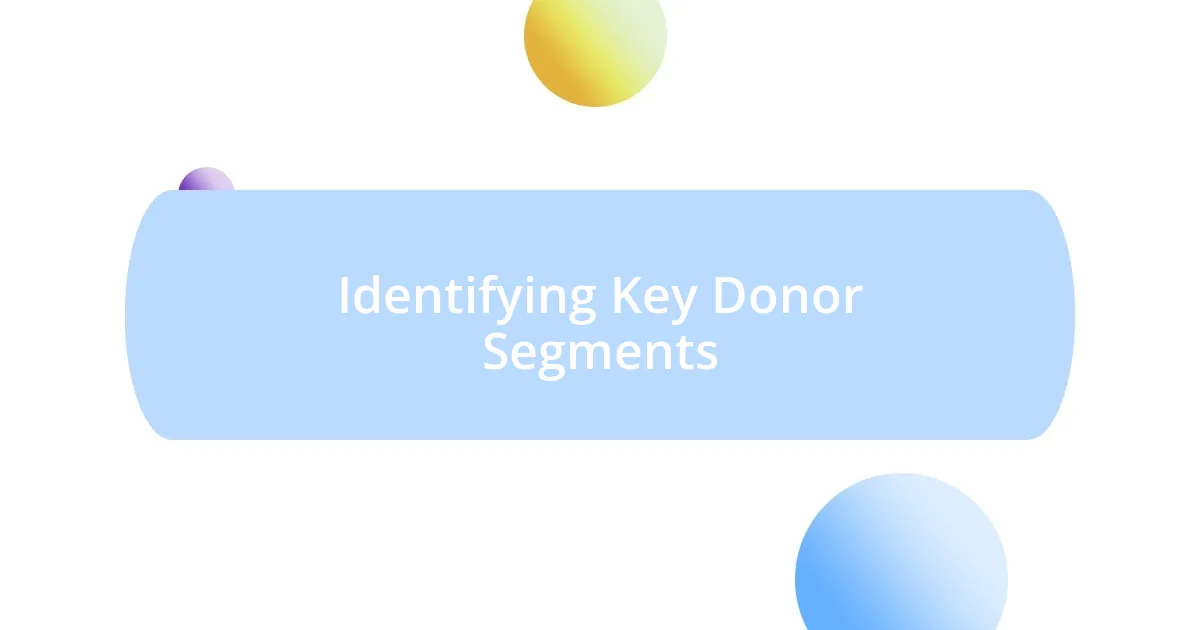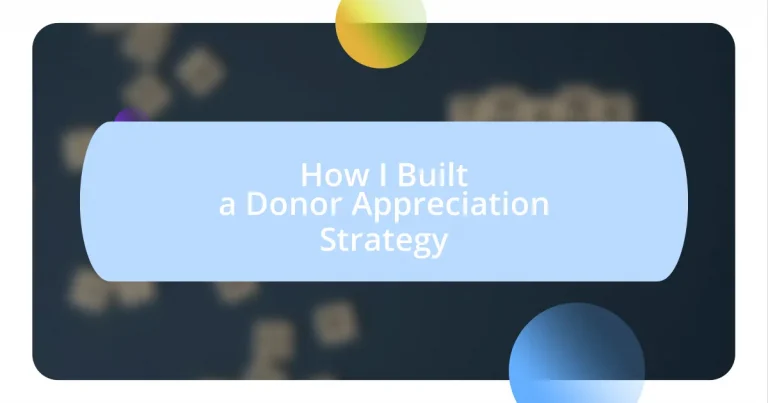Key takeaways:
- Donor appreciation involves creating genuine connections beyond simple thank-yous, which can significantly enhance a donor’s relationship with an organization.
- Identifying key donor segments through personal motivations, engagement levels, and shared values enables personalized communication, fostering deeper connections and tailored appreciation efforts.
- Implementing feedback mechanisms, such as surveys and direct conversations, provides valuable insights that help refine appreciation strategies and cater to individual preferences.
- Maintaining long-term donor relationships requires consistent communication, personalized gestures, and creating shared experiences to make donors feel valued and integrated into the organization’s mission.

Understanding Donor Appreciation
Donor appreciation goes beyond saying a simple ‘thank you’; it’s about creating a genuine connection with the people who support your mission. I remember a particular donor who shared that a handwritten thank-you note made them feel truly valued. This simple act transformed their view of our organization, reinforcing how deeply appreciation can resonate on a personal level.
When I consider what it feels like to be appreciated, I can’t help but reflect on the times I’ve felt taken for granted in various aspects of my life. It’s an all-too-common experience that can leave one feeling invisible. This understanding drives me to ensure that every donor feels not only recognized but celebrated, making sure they know their contributions matter.
Effective donor appreciation is not a one-size-fits-all approach; it requires thoughtfulness and intentionality. I’ve found that taking the time to understand individual motivations behind donations can lead to more personalized acknowledgments. Have you ever thought about what motivates your donors? Engaging with their stories can create richer narratives that deepen their commitment and connection to your work.

Identifying Key Donor Segments
To effectively identify key donor segments, I find it crucial to look beyond just the financial contributions they make. Each donor comes with their own unique story, and diving into their motivations for giving can reveal surprising insights. For instance, I once had a conversation with a donor who spoke passionately about their late mother’s favorite charity. That personal touch opened my eyes to the importance of grasping the emotional connections tied to their contributions.
When you segment your donors, consider these factors:
– Giving history: Analyze patterns and frequency of donations.
– Demographics: Look at age, location, and giving capacity.
– Engagement level: Assess how actively they participate in events or initiatives.
– Values alignment: Identify shared values between your organization and the donor.
– Personal connections: Note any personal ties to your mission or staff members.
Understanding these segments allows for tailored communication strategies that resonate on a deeper level. By doing this, I can create targeted appreciation efforts that truly celebrate their involvement.

Designing Your Communication Strategy
Designing a solid communication strategy is pivotal in donor appreciation. I’ve learned that clarity and consistency are non-negotiable in these interactions. For example, when I send out updates or gratitude messages, I strive to maintain a warm tone that speaks directly to the donor’s contributions. This way, they can feel the impact of their support on a personal, emotional level.
I’ve experienced firsthand the effectiveness of using various communication channels. Whether through email, social media, or handwritten notes, it’s essential to choose the right medium for each donor. I once switched to a more visual approach for a particular segment that preferred infographics over lengthy texts. The response was overwhelmingly positive! Tailoring the message format based on donor preferences not only boosts engagement but also showcases that I care about their experience.
A crucial element to include in your strategy is feedback solicitation. I often ask donors how they prefer to be acknowledged and what updates they find meaningful. This practice fosters a sense of community and invites deeper conversations. What I’ve noticed is that when donors feel their opinions matter, their connection to the cause becomes much more profound, fostering loyalty and continued support.
| Communication Channel | Benefits |
|---|---|
| Quick, scalable, and allows for detailed updates | |
| Social Media | Engages broader audiences; fosters real-time feedback |
| Handwritten Notes | Personal touch that creates emotional connection |
| In-Person Events | Strengthens relationships; cultivates community feeling |

Creating Meaningful Recognition Programs
Creating meaningful recognition programs is all about understanding what makes each donor feel valued. In my experience, one of the most impactful gestures was organizing a personalized thank-you event. We invited donors to share their stories during a casual gathering, which not only demonstrated our appreciation but also gave them a platform to connect with each other. It was heartwarming to see them light up while discussing their motivations and experiences, and it solidified their bond with our organization.
I’ve found that small, thoughtful touches can go a long way. For instance, sending out a custom video message highlighting the specific projects their donations supported made a significant impact. A donor once reached out, emotionally moved, saying how it felt like their gift had come full circle. Moments like this reveal the true power of recognition—when donors see the direct impact of their generosity, it fosters a sense of belonging and commitment.
Have you ever thought about the influence of collective recognition? I remember a time when we initiated a “Donor Spotlight” section in our newsletters, celebrating different donors each month. It not only honored individual contributions, but it also created a sense of camaraderie among donors, elevating their experience to one of community rather than isolation. This strategy made it clear that every donor plays a vital role in our mission, and that sense of shared purpose is what keeps them engaged and enthusiastic.

Implementing Feedback Mechanisms
When implementing feedback mechanisms, I’ve found that simple surveys can be incredibly effective. After one fundraiser, I sent a brief questionnaire to our donors, asking them what they thought of the event. The responses were eye-opening, revealing not just what they loved but also aspects they felt could be improved. I was surprised to learn that many valued a more interactive experience, which led to changes in how we organized subsequent events.
Engaging donors through direct conversations also yields rich insights. At a recent donor appreciation dinner, I took the opportunity to chat with several attendees, asking them what forms of recognition resonated with them. To my surprise, some preferred a simple phone call over public acknowledgment, emphasizing that personal connections meant more. This reminded me that every donor has unique preferences, and listening to them is key to our strategy. Isn’t it fascinating how taking the time to ask can transform our approach?
Another powerful way to gather feedback is through focus groups. I’ve hosted several discussions where donors shared their opinions on our appreciation efforts. One particularly touching moment was when a long-time supporter expressed how much she valued the handwritten notes we sent. This small gesture, mentioned in her feedback, became a cornerstone of our appreciation strategy moving forward. It’s amazing how a genuine dialogue can bring fresh ideas to light and strengthen the bond we share with our supporters.

Evaluating Your Strategy Effectiveness
Evaluating the effectiveness of my donor appreciation strategy became a pivotal step in refining our approach. One unexpected revelation came when I analyzed donor engagement metrics after a recent campaign; I discovered a significant correlation between personalized recognition efforts and increased contributions. This connection emphasized the importance of measuring tangible outcomes, such as response rates and donation levels, to truly understand what resonates with our supporters.
I also turned to storytelling as a means of evaluation. After implementing a new recognition program, I asked donors to share their experiences through a short testimonial form. I wasn’t just looking for positive feedback—what struck me was the heartfelt stories of transformation that emerged. One donor shared how our acknowledgment made her feel like an essential part of our mission, further fueling my belief that the emotional response is a compelling indicator of success. Aren’t these narratives more enlightening than mere statistics?
During my reflections, I implemented regular review sessions with my team to dissect our strategies critically. In one meeting, a colleague noted that we might be overlooking our quieter donors—the ones who don’t always engage but still contribute generously. This sparked a new initiative aimed at reaching out specifically to them, proving that continuous evaluation isn’t just about assessing what works, but also identifying the voices that matter the most. How often do we pause to consider the silent supporters? It’s a question worth exploring.

Maintaining Long-Term Donor Relationships
I’ve learned that maintaining long-term donor relationships really hinges on consistent communication. For instance, I remember reaching out to a donor who had been with us for years but hadn’t engaged recently. A simple phone call, where I shared updates and listened to her thoughts, reignited her passion for our cause. It’s incredible how a small effort like that can reaffirm their value and keep the connection alive.
One memorable experience was when I organized a small gathering to celebrate our long-term supporters. The joy on their faces as we shared recent successes was palpable, and it reminded me that fostering these relationships is as much about creating shared memories as it is about the donations. I often wonder, how do we ensure our donors feel part of the journey with us? The answer lies in continuously inviting them to participate, making them feel like key players in our mission.
I’ve also found that personalized gestures go a long way in nurturing these bonds. Each year, I send out curated gifts based on individual donor interests, and it’s heartwarming to see their reactions. One donor even told me that receiving a book related to our mission felt like a thoughtful reminder of their impact. These small, intentional acts speak volumes about how much we care, and honestly, shouldn’t every donor feel that special connection?














